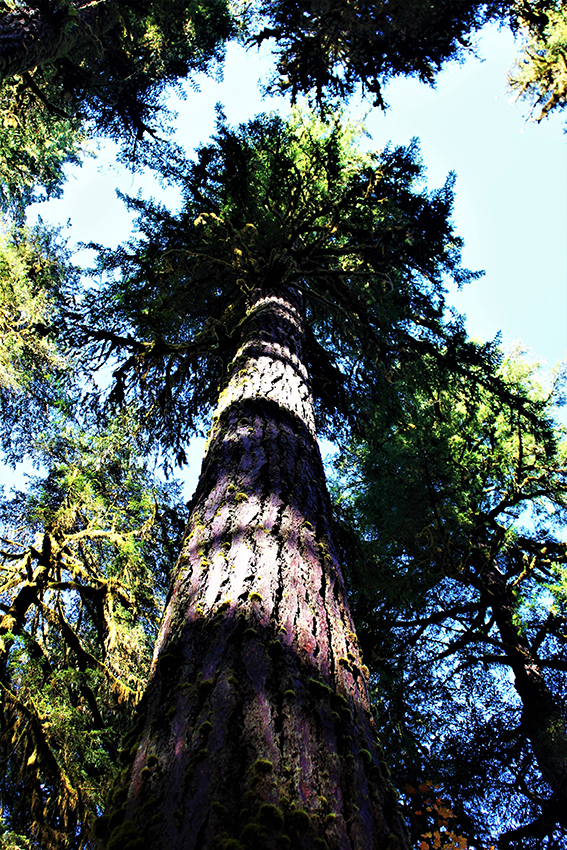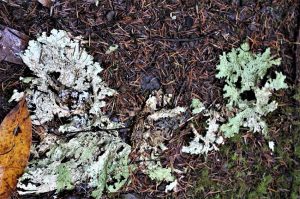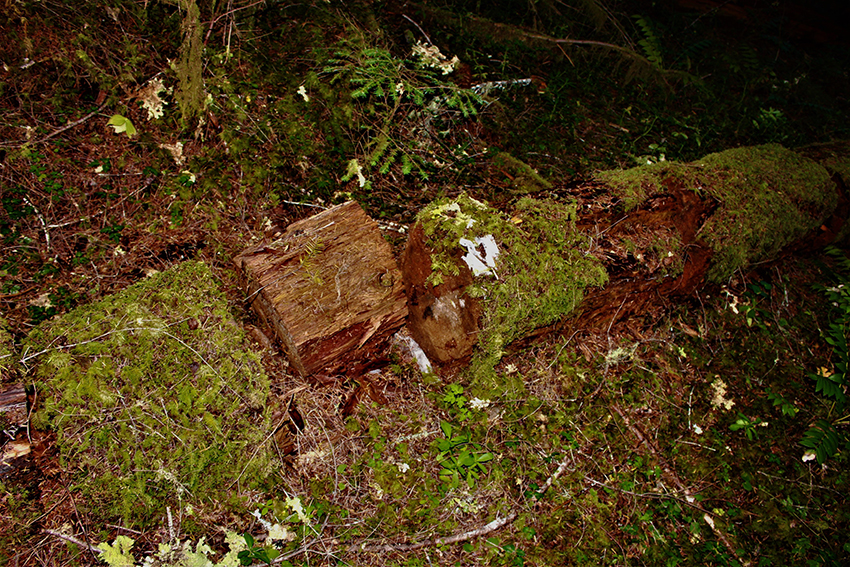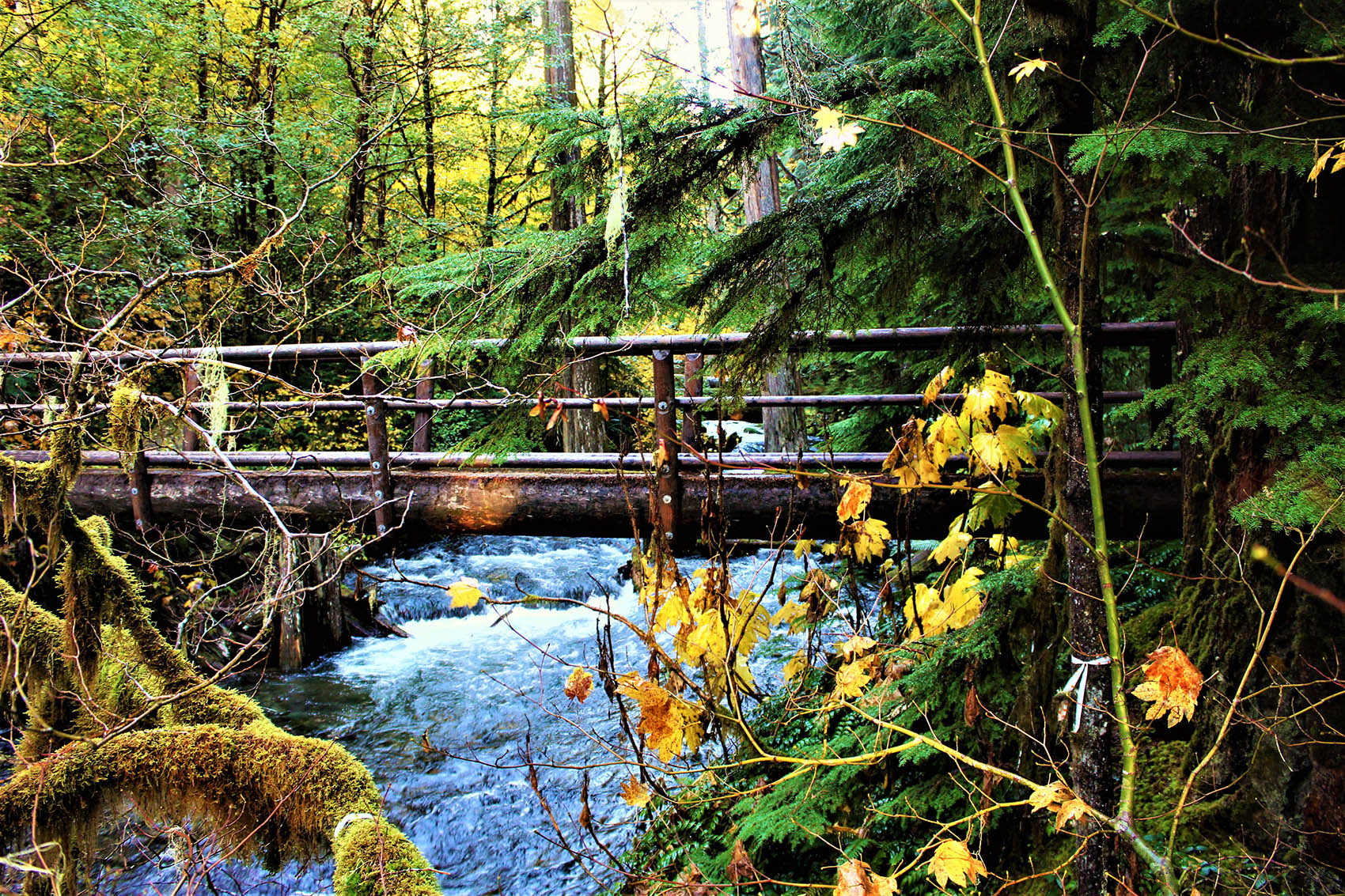

“Though we travel the world over to find the beautiful,
we must carry it with us or we find it not.”
–Ralph Waldo Emerson
A gauzy drape of clouds hung over the mountains like an old, familiar question. What am I doing here? The clouds looked thin and light, yet still concealed the rocky, jagged beauty beyond. As I shifted to low gear, to climb the steep, winding two-lane road, the clouds slowly blew over, and the Western Cascades reappeared.
I was on my way to the Andrews Experimental Forest in central Oregon for a two week visit: to write and walk, and meet a few scientists—hydrologists, botanists, biologists. Artists and scientists have different kinds of response abilities, so the hope is that the writers’ searching for words in the woods will somehow converge with the scientists’ researching for data. The language of metaphor against the language of measurement. The scientist collects numeric info with her sensors—a decaying hemlock log’s carbon emission in kilograms per year. The artist captures the rotting log with his senses—the colors and smells that reveal how life and death are convergent. Both kinds of perception matter: numbers and words, math and myth. But what’s remarkable about this program—“The Long Term Ecological Reflection Project”—is how long-term it is: 200 years. From 2003 until 2203 hundreds of writers will visit “the Andrews” to enter an ongoing conversation with trees and trout and rocks—and scientists—about our evolving relationships in our shared home.
First, the Andrews Forest in numbers: 15,000 acres of wilderness, 53 species of mammals, 164 species of birds, 3100 invertebrate species, 20 species of reptiles and amphibians, 505 plant species, 7 feet of rainfall per year, a maximum elevation of 5340 feet, 40% of the forest is old growth, 25% was harvested for timber, the tallest tree is 299 feet high, the oldest about 700 years. Lookout Creek’s mean annual discharge: 121.83 cubic feet per second.
The Andrews, which was established in 1948, is remote but not untouched. Hundreds of red, black and white ribbons knotted around hemlock and fir and cedar branches mark various botanical studies. And dozens of thermometers and gauges and infrared cameras monitor everything from tree surface temperature to leaf breakdown in streams, to how soil nutrients impact carbon storage, root decomposition, and nitrogen fixation in trees and other plants.
But back to my original question: The emphasis is on “I.” What was I doing there? After ten hours of travel—4 in a plane and 6 in a car—and still a half hour away from the Andrews, I was beginning to have doubts. Oregon is a gorgeous drive-to state, but I know little of the culture or ecology of the region. I’m a life-long Midwesterner—from Iowa, a drive-through state, an economically productive but damaged, defeated sort of landscape.
I learned long ago what Iowa stands for: Idiot Out Walking Around. Who doesn’t love such comic humility? I do. There are no national parks or forests or sea coast in Iowa, or any professional sports teams. The highest “mountain” is Hawkeye Point, near Sibley, at 1670 feet. And there is one enormous green ocean that covers the state—13 million acres of rippling, waving corn. Yet the beauty in Iowa overwhelms me: the sweet, musty scent of freshly cut hay, a raccoon waddling out of waste-high weeds like a little furry tank, a slow string of cattle grazing along the fence line at dusk in the soft, golden light. I lived in that beauty for two decades, but didn’t know it then—that all those years fishing and hunting along the railroad tracks and walking beans and castrating pigs and trimming apple trees and picking sour cherries all led to the daily miracle of feeling at home there.
So how do we learn to see beauty in nature, wherever we are, and to belong to it? And can/should that be measured?
These are the kinds of questions I hoped to pursue during my short stay at the Andrews. Beauty isn’t hard to find there. Huge stands of lichen-draped old growth forest filter the cold clear water that rushes through sparkling trout-filled streams as they tumble through the woods. Douglas-firs—500 years old and 280 feet tall—form a canopy over a complex understory of plant life that includes hazelnut, vine maple, rhododendron and dogwood. Decades of intensive study of the forest has yielded all kinds of useful insights to ecologists. The most recent is that such a canopy might buffer the wider ecosystem from rising temperatures caused by global warming. This moderation within the forest may also help conserve temp-sensitive bird, amphibian, and insect populations. And it might counteract the now misaligned phenology: like if the temp-dependent huckleberries fruit a month early (March) but the birds, whose migration is tied to light/day-length, still arrive in April to feast on the berries, and there are none left.
Though it is a site of intense research, the Andrews still feels like wilderness to me. Even the “lesser” stands of trees there, the managed fir plantations—planted 60 years ago as a lumber crop—are as old as most of the trees I grew up with in Iowa, where everything is harvested. I remember an Iowa ad campaign motto in the seventies when I was a kid—“Iowa: A Place to Grow.” The goal was to attract more tourists and residents. The problem was everyone knew they’d left out the final word: corn. A later promo campaign, in response to the mass exodus of Iowans to other states in the nineties, had a different motto: “Come Back to Iowa, Please.” But they never did.
Iowa again. I’m not sure why the comparisons linger. I guess I have a chip on my shoulder. My Midwestern pride and identity is easily threatened. Though I don’t have Oregon-envy. I’ve watched Portlandia; so know that people are nutty there too. So what is it? I was invited to come to the Andrews. And I’m on sabbatical, which is precisely the time to explore new places. But how much can I see in a Northwestern forest through the lens of a Midwestern life. I know coyotes and cardinals and white pines, not newts and dippers and western hemlocks. What can I possibly write about? My fear: I’m just a tourist, a site-seeker.
Tourists look at rather than see. They are collectors of bucket-list destinations, to which they fly for a day or two in order to snapchat a dozen selfies to prove they’ve arrived. “Here I am at Yellowstone.” “Here we are at Glacier.” Now on to the next site! The pictures all look the same. And since I’ve been a tourist, I know how we think: short term. Which is why the “packaged tour” is so popular; it’s contained, predictable, comfortably exotic and provides immediate gratification. Yet such trips rarely allow us to consider how we impact and are connected to the natural beauty we so long to document on our cell phones.
But the searching/seeing at the Andrews Forest is long term, and reflective, which is antithetical to modern life. What does “long-term” even mean in a frenetic culture of convenience, where Amazon will overnight a still-writhing Maine lobster to your front door in time for dinner. Why “reflect”—a slow ponderous process—when the world demands that you react, that you Tweet! Response without reflection. Exhibit A: the familiar 6:00 a.m. mating call of the Orange-crested Trump Finch. “Lookatme! Lookatme! Lookatme!” Or “Doyouseeme? Doyouseeme?” Doyouseeme?” But most people know that people are not birds. Birds live in biotic harmony with their habitat. People do not.
Like an old growth forest, true reflection takes time; it’s slow and gradual. And like old growth, it’s increasingly rare. In part because our sense of time has been radically altered by technology. We are now multi-present multi-taskers, who live in virtual realities, rather than in one real place at one time. The new hi-tech human animal is more “productive,” but less patient, and attentive, and always in a hurry. Which is probably why those flat, corn-fed Midwestern states, like Iowa, are no longer 5-hour drive-throughs, but 15-minute fly-overs. You don’t even need to look anymore.
But some still do: those who live(d) there, or live nearby. I do—sometimes. And I still long to spend most of my time on the ground, to be rooted somewhere. My hope: the difference between a drive-through state and a drive-to state is not geographic spectacle—not the snow-capped mountains or rocky coastline. It’s about the driver, and what she’s capable of seeing, and where he thinks he’s going, and how she understands arrival. All states are drive-to states if you’re paying attention.
Which is the central point of my stay at the Andrews Forest: to pay attention. Like all of the writers—I focused my time there on a few designated long-term reflection sites, which I visited many times, to wait and watch and write in my journal. Two of these journal entries follow.
Journal 1
Every morning before leaving my studio, I read a poem or short passage to serve as a spiritual compass for the day—a prayer of attention to carry with me into the woods. Today’s guidepost comes from Terry Tempest Williams.
“The world is holy. We are holy. All life is holy. Daily prayers are delivered on the lips of breaking waves, the whisperings of grasses, the shimmering of leaves.” (source)
As I climb into my car to drive to the first Reflection Site—the Log Decomposition Plot (“the Cathedral of Rot”), I wonder if prayers are also delivered in the wet, spongy stink of decaying logs. My favorite term in the description of this site was “butt rot.” I found it pleasingly crass amid all of the scientific jargon. The butt/base of an old growth tree could be rotting for a century before the tree fell and died. But it doesn’t die, not really. It decays. Decay means “to fall away”—to return to your constituent parts, what you’re made of. So for me, a tree falling away, or re-turning into earth, is a part of a process, not the end of one.
I wind through the woods on a muddy one-lane national forest road, trying not to get stuck. The Log Decomp Plot is five miles from the Andrews headquarters. There’s no cell reception and I didn’t bring the two-way radio they gave me for “emergencies”—too heavy to carry. My rental car—a Mistubishi Mirage—is the kind that could be picked up and carried away by four large men. It doesn’t inspire confidence.
Soon I recognized the cutout along the forest road, marking the trail that leads to the rot plot. As I tramped back into the rainy forest an old question drifted up, like the mist from the forest floor: What am I doing here? The forest felt foreign again—more tropical, more like Nicaragua or the Philippines than Iowa. The Andrews is defined as a quasi-Mediterranean climate—mild, moist winters and warm, dry summers. But what I notice is all of the trees wearing furry moss-green coats, and that it’s raining moldy lettuce: little grey-green pieces of crinkled, thick-veined leaves falling on me from the canopy 200 feet above. Fred Swanson, the kind, brilliant ecologist who first oriented me to the forest, later explained that it was Lobaria falling onto my shoulders. This remarkable lichen, which only grows in forests 100+ years old, loosely attaches itself to branches and is easily blown to the ground. It fixes nitrogen directly from the air, making it available for other plant and animal life on the forest floor, where mycorrorhizal fungi capture and transfer the nitrogen to host plants.

Mark Harmon, the forest ecologist who initiated the log decomp study, was also focused on ground level decay. In 1985, working with the U.S. Forest Service and other scientists, Harmon cut down and sectioned four species of trees, each representing a different decay rate: silver fir, western hemlock, Douglas-fir, and western red cedar (fast to slow). He then dispersed these logs (over 500) in six different locations in the Andrews to monitor the rate/process of decay and its impact on the ecology of the forest. He is measuring everything from annual carbon emission to how the various decomposers (white rot fungi versus brown rot fungi) break down different parts (bark, heartwood, etc.) of the different tree species. Why does this matter, a non-scientist like me might ask. Because, according to Harmon, these different fungal groups and the varied rates of log decomposition impact nutrient cycling and carbon sequestration. Translation: his research shows that deadwood in native forests plays an essential role in carbon storage and in maintaining the ecological balance of the forest.
After a ten-minute hike I arrive at the log decomp site: a scattering of 12-foot-long log sections lying about in various states of decay. Some have been sawn into cross-sections, or “cookies,” for analyzing nitrogen and “rot zones” and the impact of invertebrates. A large diamater PVC pipe is glued to the flank of a red cedar log to sample its CO2 output. The red cedar’s bark and heartwood are hard and firm. This tree will take 500 years or more to completely break down, exceeding the length of the study, which is also 200 years (running until 2185). The silver fir log next to the cedar, however, has nearly disappeared since the study began, two thirds of the tree rotting back into the earth and blowing off into the atmosphere. I can stick my finger into the damp mush of the heartwood. After just 35 or 40 years this tree will have completely disintegrated, rotting into rich new soil in which seeds will take root.


I sit on the rotting red cedar and look up at a soaring Douglas-fir and wonder if it can remember the centuries of snow storms and fires, and all the owls who gutted and ate mice or squirrels on its branches. But the tree perpetually re-members and sustains our shared world in more practical ways—by producing oxygen and absorbing CO2 and providing habitat and food and preserving water and preventing erosion. The very oldest living trees can do this for thousands of years. A bristlecone pine tree, for instance, growing under stressful conditions in the mountains, can live for more than 3000 years. Now that’s long term.

Today, sitting here amid the rotting logs, time feels oddly relative and elusive. So does death. I think of the mantra that I started the day with: “The world is holy. We are holy. All life is holy.” Here the “daily prayers” are delivered by the mycelia of fungus, and by the shallow burrows eaten away by bark beetles, who open pathways for other decomposers with their chaotic galleries—an evolving maze of decay that leads from life to death, and back again.
One of Mark Harmon’s discoveries is that a decaying log can contain more living tissue than a live tree. “The tree that’s green and standing up is the one they should call ‘dead,’ he says. “The tree down on the ground is the one that’s really alive.” A dead tree is more alive than a live one? Huh? Surely that tells us something about the living process of decay. Is the break between life and death amid the miraculous process of (re)creation really a bridge? Is decay life after death, or life after life? Is death an endmark or a transition, a period or an ellipsis? Does the mushy carcass of a 40-year-old silver fir tree warrant a final eulogy, or a prayer of awe and wonder?
Journal 2
Today’s early morning inspiration comes from a favorite poet—William Stafford—who spent much of his life in Oregon:
Is there a way to be gone and still
belong? Travel that takes you home?
Is that life?–to stand by a river and go.
To stand by a river and go. The image lingered as I stepped out of my studio into the rain and headed toward the second long-term Reflection Site: the gravel bar on Lookout Creek.
Drip-tick, goes the rain on the yellow maple leaves above me. Drop-tock, goes the rain in the puddles collecting on the ground. Ping-tick goes the rain on the shiny black cedar log. Plop-tock goes the rain on the overturned plastic bucket some researcher left. Drip-tick, drop-tock, ping-tick, plop-tock. The cool wet drum of the rain is nuanced and lovely—until I get within 100 yards of the river, and the rush of whitewater overwhelms everything.
Travel that takes you home. If I’m only on my way to somewhere, like a tourist, I may end up in a state I don’t want to visit—the state of longing—rather than Stafford’s “home” state of belonging, where I still hope to arrive some day.

Now I’m sitting on a flat rock in the hard rain listening to the creek. This is my job: to sit in the rain and listen. Were it a deeper stream without rocks or deadfalls or much current, and full of sediment, it would be quiet and still (and more Midwestern). Lookout Creek is crazy fast from three days of rain, and full of rocks and boulders and deadfalls, and so it has a lot to say. Over time, the gurgling water will tumble and dissolve rock, and rot logs and leaves and carry them downstream, along with trout and pine pollen and needles and cones, and bits of moss and lichen. Over time it will reshape its bed and banks and habitat, physically describing its character and history in this forest. Over time it will reflect and respond to climate change and other challenges posed by human beings. Over time, as with all streams and rivers, it will measure and reveal both our culpability and response ability as a species. Over time it will measure who we are.
Over time. That’s two words. Not “overtime.” Not hours or numbers, but a river of light and darkness, of heat and cold. Over time, things change. Some change is dramatic—what ecologists call “a disturbance”—like the rotting 400-year-old Douglas-fir that fell across the creek 30 years ago during a flood. The crashing tree ripped a wide gash in the canopy, prompting slower, less dramatic change below: a thick stand of Alder trees sprung up on the gravel bar amid the flood of new light. When the Doug-fir fell, its bole and branches obstructed and partly dammed the creek, forming a deep pool—where, over time, native trout came to live, and to wait and watch for midges and flies to light on the water.
Waiting and watching. Over time. To stand by a river and go. That rainy day I lingered by the water all afternoon, scrambling around on the slippery rocks like the child I once was—completely lost in the moment—and hoping to see something: a bird, or a snake, or a beetle, or a frog, or anyone who might re-member me, and remind me how I belong.
Just before leaving, when I looked down into the deep blue pool behind the fallen Doug-fir, a small cutthroat trout appeared—maybe 8 inches long, his spotted back a foot below the surface—slowly drifting, waiting and watching, scanning for drifting bugs. Could he see me? As I watched him, I couldn’t help but think of the red-tailed hawks I love—how they drift in a softer, deeper blue, scanning an Iowa hayfield, waiting and watching for a vole to scurry out of the tall grass into the open sunlight, where death awaits. And life.
Death and life. Walking along the creek back to my studio, I ponder the convergence and transitions between the two—and consider that bottomless moment when this rushing water finally reaches the ocean, and suddenly, yet completely, becomes a part of the whole. The movement slowing to a deepening stillness. Travel that takes you home.
Photos were taken by the author in the Andrews Forest in Oct., 2017.
Note: The long term ecological reflection program described here is “The Spring Creek Project for Ideas, Nature, and the Written Word,” and is a collaboration of Oregon State University, the Andrews Forest, and the Forest Service.
